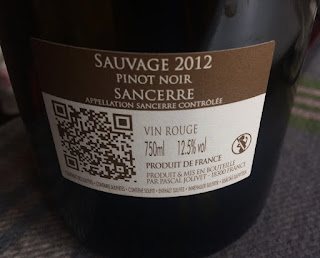Pascal Jolivet neck label
A couple of weeks ago I received a box of samples of his current releases kindly sent by Pascal Jolivet. I have been enjoying tasting them and this post covers the first seven.
2017 Attitude, IGT
(Above and below)
2017
Attitude, IGT Val de Loire Attitude comes from 60 hectares of vineyards managed by Pascal Jolivet with at least 30 hectares in region of Châteaux de Cheverny and Cheverny. Attitude comes in all three colours – white (Sauvignon Blanc), red (Pinot Noir) and rosé – Pinot Noir, Gamay and Cabernet (a third of each). For this Sauvignon Blanc the grapes come from two areas of Chemery (limestone) and little further west Angé sur Cher (flint).
The 2017 Attitude has some
grassy notes as well as plenty of grapefruit flavours, attractive soft texture and some
length. There is an impressive quality of cork for this cuvée.
2017
Sancerre
This is from Jolivet's Signature range and is a blend of Sancerre three different types of soil blending 50% limestone (caillottes), 30% clay limestone and 20% flint. It has weight
and concentration, is quite flattering but without the complexity and finesse of
the Clos du Roy.
2017
Clos du Roy, Sancerre Blanc
The 18-hectare Clos du Roy is in the commune of Crézancy of which Jolivet has 0.8 hectares of this clay-limestone vineyard. This Clos du Roy spends four months on its fine lees. It has a citric
lightly grassy nose, finesse and elegance, delicate and well balanced Sancerre.
2016
Sauvage, Sancerre Blanc
Sauvage comes from two hectares of organic old vines between the villages of Champtin, a hamlet to the west of the village of Bué. It stays for 12 months on its lees before bottling. The 2016 Sauvage has the potential
to improve further. Sauvage is very precise and clean with a mineral character. Grapefruit, citric, good length with a significant length and quality of cork.
2016
Indigène, Pouilly-Fumé
The grapes for this cuvée comes from old vines planted on flint in the small village of Tracy sur Loire, which is just beside the Loire. Vinified in stainless steel Indigène spends 12 months on its fine lees. The 2016 Indigène is delicate, with citric flavours, especially grapefruit. Perhaps
needs more time to take on more weight?
2016 La Bondenotte, Sancerre Rouge
The Pinot Noir for La Bondenotte from 0.86 hectares of vines owned by Pascal Jolivet in the three hectare La Bondenotte (clay-limestone) in the Bué commune. It is matured for eight months in demi-muids (600-litre barrels). La Bondenotte is a lighter
style of Sancerre Rouge with raspberry fruit very much to the fore.
2012 Sauvage, Sancerre Rouge
2012
Sauvage, Sancerre Rouge
The Pinot Noir for Sauvage comes from a one hectare vineyard in the centre of the commune of Bué, whose old vines were planted in 1952. It is vinified in demi-muids (600-litre barrels) where it is aged for 15 months. This is an impressive and serious red Sancerre – silky, seductive with good concentration and has the potential to age and improve further.



















No comments:
Post a Comment